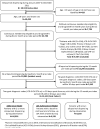Modifiable factors associated with allopurinol adherence and outcomes among patients with gout in an integrated healthcare system
- PMID: 25512479
- PMCID: PMC4922495
- DOI: 10.3899/jrheum.140588
Modifiable factors associated with allopurinol adherence and outcomes among patients with gout in an integrated healthcare system
Abstract
Objective: To identify modifiable patient and provider factors associated with allopurinol adherence and the achievement of a serum urate acid (SUA) goal in gout.
Methods: We identified a retrospective cohort of patients with gout, newly treated with allopurinol. All patient data came from administrative datasets at a large integrated health delivery system. Patients were ≥ 18 years old at time of initial allopurinol dispensing, and had 12 months or more of membership and drug eligibility prior to the index date. Allopurinol adherence was defined as a proportion of days covered ≥ 0.80, evaluated during the first 12 months of observation after the initial dispensing. Multivariable logistic regression was used to examine factors associated with allopurinol nonadherence and attaining an SUA concentration < 6.0 mg/dl.
Results: We identified 13,341 patients with gout with incident allopurinol use (mean age 60 yrs, 78% men). Of these, 9581 patients (72%) had SUA measured both at baseline and during followup. Only 3078 patients (32%) attained an SUA target of < 6.0 mg/dl during followup. Potentially modifiable factors associated with treatment adherence and obtaining the SUA goal in the multivariable analysis included concomitant diuretic use, prescriber specialty, and allopurinol dosing practices. Adherent patients were 2.5-fold more likely than nonadherent patients to achieve an SUA < 6.0 mg/dl during observation.
Conclusion: Among patients with gout initiating allopurinol in our study, 68% did not reach the SUA goal and 57% of patients were nonadherent. Modifiable factors, including allopurinol dose escalation, treatment adherence, rheumatology referral, and concomitant medication use, could be important factors to consider in efforts aimed at optimizing gout treatment outcomes.
Keywords: ADHERENCE; ALLOPURINOL; GOUT; INCIDENT.
References
-
- Becker M, Schumacher H, Wortmann R, MacDonald P, Eustace D, Palo W, et al. Febuxostat compared with allopurinol in patients with hyperuricemia and gout. N Engl J Med. 2005;353:2450–61. - PubMed
-
- Schumacher H, Becker M, Wortmann R, Macdonald P, Hunt B, Streit J, et al. Effects of febuxostat versus allopurinol and placebo in reducing serum urate in subjects with hyperuricemia and gout: A 28-week, phase III, randomized, double-blind, parallel-group trial. Arthritis Rheum. 2008;59:1540–8. - PubMed
-
- Sundy J, Baraf H, Yood R, Edwards N, Gutierrez-Urena S, Treadwell E, et al. Efficacy and tolerability of pegloticase for the treatment of chronic gout in patients refractory to conventional treatment: Two randomized controlled trials. JAMA. 2011;306:711–20. - PubMed
-
- Zhang W, Doherty M, Bardin T, Pascual E, Barskova V, Conaghan P, et al. EULAR evidence based recommendations for gout. part II: Management. report of a task force of the EULAR standing committee for international clinical studies including therapeutics (ESCISIT). Ann Rheum Dis. 2006;65:1312–24. - PMC - PubMed
Publication types
MeSH terms
Substances
Grants and funding
LinkOut - more resources
Full Text Sources
Other Literature Sources
Medical

